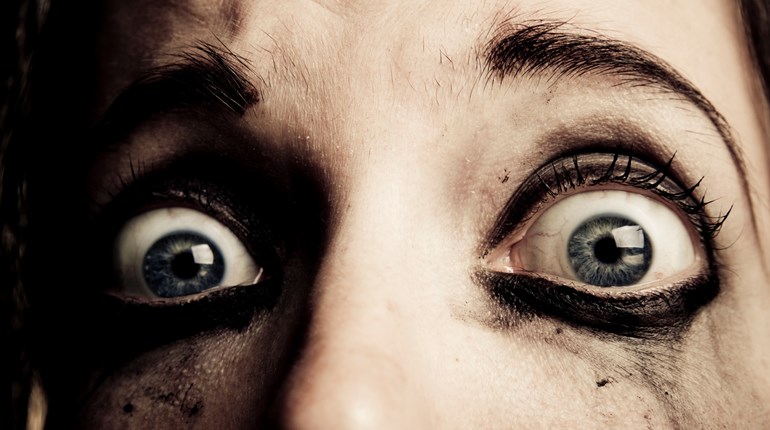
While reporting from Kyiv, Ukraine, in March, I found myself swimming in a horrific, frightening, wonderful mix of dread, compassion and desperation to remain free. The literal tool for that freedom—many types of guns—were in Ukrainian’s hands. Shopkeepers, school teachers, engineers and professional soldiers were all armed and ready to fight for individual and national liberty.
I soon learned that, in late January, inside a snowy village on the outskirts of Kyiv, civilians came to learn to shoot AK-47s. This was part of widespread training courses designed to teach as many people as possible to defend themselves against the then-possibility that Moscow would invade. These were often family affairs, with husbands, wives, grandparents and children taking part together.
“We often think about the Second Amendment of the U.S. Constitution. We know it’s not only about self-protection, but the protection of freedom and our independence,” a Ukrainian constitutional-lawyer-turned-volunteer medic told me. “An invasion could happen to anyone, and every Ukrainian must be prepared for anything.”
Ukraine’s ordinary citizens often say that their desire to bear arms arises not only from concerns over foreign actors but also from a healthy distrust of their own government. The Maidan Revolution at the beginning of 2014, for example, was a major catalyst for change as demonstrators called for democracy and the removal of Vladimir Putin’s puppet, then-President Viktor Yanukovych.
Yet it was Kyiv’s own police forces who turned violent on the peaceful protesters—slaughtering dozens in cold blood. Authorities even stormed into public hospitals and arrested the wounded and dying. It wasn’t until a significant portion of Ukrainians took their own guns to the famed Maidan “Independence” Square as a deterrence that the riots simmered and Yanukovych was forced out.

While Ukraine finally had its first taste of democracy in the name of free and fair elections, Putin embarked on a vicious retaliatory tirade by annexing Crimea and backing pro-Moscow separatists to violently wrestle control over parts of Ukraine’s eastern Donbas region, the first evolution in the conflict that drags on today.
From that point on, guns became a household necessity for many. The issue wasn’t political; those bearing arms were doing so to fight for personal freedom and were willing to take matters into their own hands to protect it if necessary.
“Everyone should have a gun,” a prominent politician named Igor said to me quietly over coffee. “This isn’t a taboo matter.”
The much-hyped fear of a Russian incursion became a chilling reality in the dawn hours of February 24, when Russian President Vladimir Putin launched a full-scale land, sea and air assault on Ukraine. The bubble of relative safety had burst, and the entire country of 44 million was thrust into bitter conflict with one of the most-powerful militaries in the world.
Almost every defense and security talking head at the time insisted that Ukraine and its comparatively under-equipped armed forces would likely last just a couple of days against the feared Red Army. But weeks into the war, as this was being written, such a sentiment had been proven wrong. At the time of this writing, Ukrainians were holding their capital against a bitter enemy. Weapons like stingers and javelins matter, but what has mattered just as much is the notion that many civilians must take part in the fight.
On a muted gray late morning in March, as rockets cracked the skies and smoke mushroomed in the near distance, I met an American volunteer helping to transport the weakest and most-vulnerable civilians across a blistered bridge as they fled the all-out onslaught of their homes with little more than small suitcases and plastic bags to survive a displaced life.
“This has changed my views of the Second Amendment,” the American told me. “This can happen to anyone, and although everyone wants to tell you that an AR-15 can’t possibly stand a chance against a heavy tank, this fight proves otherwise.”

Ukrainians often tell me that marksmanship and self-defense are embedded in their DNA. Ukrainians like to take you through the jagged path of history, highlighting that medieval Ukrainians during harvest always had a weapon on hand, ready to fight if someone invaded their terrain. In 1917, the Soviets began collecting arms from the civilian population. Then, during World War II, people began to take up arms again as there were “no rules.” Eventually, after the war ended in 1945, guns were again collected by the state. For some, though, it took a specific event to trigger them to take up arms.
Luda, a 30-year-old I.T. professional originally from the occupied Donbas region, recalls watching the August 2014 Battle of Ilovaisk unfold in real-time. The Armed Forces of Ukraine launched an offensive mission to retake the strategic city of Ilovaisk from pro-Russian insurgents, but they were surrounded, outnumbered and out-gunned. Most chillingly, an agreement for them to retreat safely through a green corridor was not followed, resulting in a bloodbath.
“It made me think if anything like this happened, how could we defend ourselves? So my whole family bought firearms,” she told me tearfully before fleeing west to Poland.
Sadly, that is precisely what we see happening to ordinary citizens as this brutal conflict goes on. Each day, civilians attempt to retreat through “humanitarian corridors” amid a heavy Russian bombardment.
Other realizations are also brought about by war’s flames.
“I am not a fighter, but the gun is important now because the police are busy with other things, and we can’t call them if something goes wrong,” Lukas, a 35-year-old filmmaker, said. “And just because we have a war doesn’t mean that all the looters, thieves and other criminals have left.”
My Kyiv-based friend, Genn, refers to the across-the-board arming of the populous as “the peaceful way of the gun.”
Compared to most European countries, Ukraine is not entwined in stringent gun-control legislation. Instead, Ukraine has historically allowed its citizens to own semiautomatic rifles and shotguns after receiving a permit from the authorities. There are no magazine limitations, no purchase-holding periods, no variables from province to province. Some I’ve spoken to have proudly stated that they are much more American than they are European in this way.
As the 2022 conflict began, President Volodymyr Zelenskyy called for the emergency easing of some existing restrictions, including allowing civilians to own and carry handguns. Previously, Ukrainian citizens were barred from having guns outside of their homes. By easing firearm regulations, Zelenskyy helped to give his embattled country a fighting chance.
“Now it’s the intention of the parliament to liberalize ownership of armaments by citizens,” stated Dmytro Shulga, the European program director at the International Renaissance Foundation, an NGO in Kyiv. “And I think that this is very popular news now.”
Anyone who wants to possess arms against the Russians can also be issued even an automatic weapon from local officials. In the lead-up to the invasion, over 25,000 automatic rifles and 10 million rounds of ammunition were distributed to volunteers in Kyiv alone.
Even foreigners who chose to come fight have been handed weapons. In the weeks leading up to the conflict, gun stores in and around the capital reported they were quickly selling out of AR-10s and AR-15s.

Scores of Ukrainians of all stripes also took their own firearms and joined their country’s Territorial Defense Forces (T.D.)—the civilian branch of the Armed Forces—thus enabling weapons shipments to be directed to those on the frontline.
“The more that civilian fighters can bring their own arms and ammo means that our military can take what it needs,” said Georgi, a 27-year-old T.D. Commander originally from the heavily battered city of Kharkiv.
Many declined to join any official government entity, and instead came together in their neighborhoods to establish unofficial checkpoints and began taking turns in the sub-zero weather to protect their homes and their loved ones inside.
One time, I spluttered hours through back roads in the dead of night from Ukraine’s Carpathian Mountains to reach the capital as artillery boomed nearby. Every few miles, we stopped at unofficial checkpoints guarded by local men stacked behind their sandbags, ready to stamp out any potential Russian “saboteurs.”
Nonetheless, as I perused U.S. news websites from Ukraine, I found op-eds and analyses worrying that giving more U.S. weapons to Ukrainians “could create a spike in illicit arms trafficking.” I clenched my fists at these gun-control proponents reflexively looking at this war through their ideology, a belief system created and fostered in academia’s ivory towers and their “safe spaces.” They didn’t seem to understand that an actual, non-hypothetical, conflict is in play—a conflict that can only be won with the support of ordinary citizens bearing arms in defense of their treasured homeland.
Still, as I listen to incoming artillery, I also see many traditionally anti-Second Amendment cable networks and newspapers in America declaring we all must “stand with Ukraine” as they come close to applauding Ukrainians for arming themselves and fighting for their freedom. Yet, it never seems to occur to these typically anti-gun news outlets that if this can happen to Ukraine, a country in the middle of Europe, why could conflict not happen anywhere? What would we do if the entire citizenry were disarmed because of draconian gun restrictions?
The blood-spilling across Ukraine has also prodded other European nations to re-imagine their staunch opposition to private gun ownership; in particular those who once belonged to the USSR, which prohibited personal possession.
“I don’t think Putin will stop at just Ukraine; he wants all of the USSR back,” Joanna, a nurse in the Polish city of Krakow, said. “Does that mean Poland will be next? How will we protect ourselves if all our military and police are called away to defend the borders?”
Indeed, the tragedy of Ukraine reinforces why the “right to keep and bear arms” is pivotal to peace and national security in the present day, as no one knows when first responders might have more pressing matters than to respond to your 911 call. Let us not forget that all those years ago, a group of armed men banded together to push back against tyrannical rulers right here at home and that democracy is always an ongoing work in progress. The Second Amendment is not a privilege or a right granted, but your inalienable right that no entity can legally take away.
As for Ukraine, nobody knows what the coming days, weeks, months or even years will bring for the blood-stained nation. Yet what is strikingly evident among Ukrainians is that they will not be idle victims in their own land. They will not cower or surrender their freedom.
“The contribution of civilian resistance matters every bit now,” Genn said as we stood on the surreal streets of Kyiv. “This is the thing that can make or break us.”


































